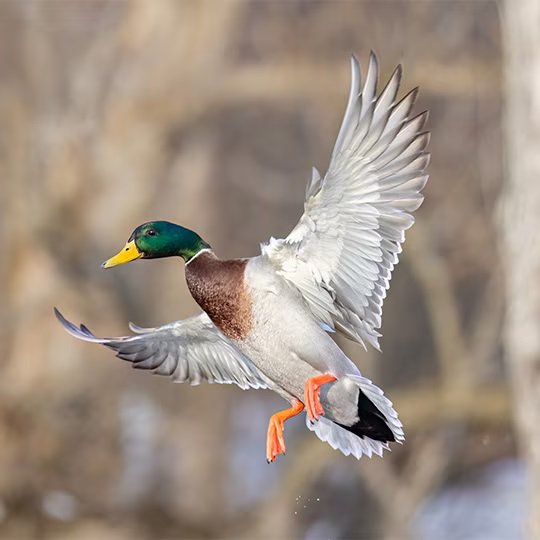Birds have always been popular mainstays of SeaWorld® parks. Many thrive in marine and coastal environments, which makes them a natural fit for a park dedicated to ocean life.
The presence of avian species in the theme park also helps tell the story of interconnected ecosystems that include shorelines, seas, lakes, and other bodies of water.
Some birds at SeaWorld® parks are part of conservation programs. As such, guests get a chance to learn about the rescue and rehabilitation of birds, and the importance of protecting them and other animals.
The animal care experiences in Abu Dhabi, which SeaWorld® Yas Island, Abu Dhabi offers, include avian species that serve as ambassadors. These engaging and fun educational presentations inspire curiosity and appreciation for these animals.
As important parts of SeaWorld® Yas Island, Abu Dhabi, birds remind guests that every species, big or small, plays a role in maintaining the delicate balance of nature.
Exploring the Majestic Birds of SeaWorld® Yas Island, Abu Dhabi
Below are some of the most fascinating avian species you can discover and get up close with at SeaWorld® Yas Island, Abu Dhabi:
- Penguins
Although flightless, penguins are birds. More specifically, they are marine birds that have adapted to living in the ocean. Some species spend around 75% of their lives at sea and only leave the water to molt and breed.
Like other avian species, penguins have wings; however, they don’t use these paddle-like flippers to fly, as they’re mainly for swimming.
Penguins are short-legged and have a stocky appearance. Most species have a back with a black or dark shade and an underside with a white or lighter color.
There are 18 species of penguins, several of which are listed as near threatened, which means their population is decreasing.
SeaWorld® Yas Island is home to six species of penguins, which are:
- King penguin
- Gentoo penguin
- Northern rockhopper penguin
- Chinstrap penguin
- Macaroni penguin
- Adélie penguin
You can learn more about and get up close with these fascinating birds with SeaWorld® Abu Dhabi’s Penguin Encounter Packages. You can also see them at the Antarctica Realm.
- Puffins
Puffins are another type of marine bird that’s just as adorable as penguins. However, unlike penguins, they can fly, even if their wings are small.
These seabirds are also experts at diving and swimming. They use their wings and webbed feet to dive and swim underwater to search for fish.
Like penguins, puffins spend most of their time at sea. They rest on the waves when not swimming and only come ashore to mate and nest.
Puffins earned the nicknames “sea parrots” and “clowns of the sea” because of their huge parrot-like beaks and black and white feathers.
There are four species of puffins, all of which are, thankfully, not classified as endangered. However, their population has been decreasing in some places, and as such, there is a need to protect them.
You can find puffins at SeaWorld® Yas Island’s Arctic Realm.
- Flamingos
Flamingos are one of the most recognizable birds in the world. They are known for their bright pink feathers, long legs, and S-shaped necks.
These majestic and graceful birds are born white. As they age and diversify their diets, their feathers turn pink from eating shrimp, snails, and algae rich in carotenoids, the substance that gives them their vibrant color.
These wading birds are often found in shallow lakes, lagoons, and coastal wetlands, aquatic areas that make it easy for them to use their beaks to filter-feed on tiny organisms. They are among the most social animals in the wild, often living in large flocks.
There are six species of flamingos. Two are listed as near threatened, and one is classified as vulnerable.
See these beautiful birds and discover ways to help conserve their number at the Tropical Ocean Realm.
- Keel-billed Toucans
The keel-billed toucan is known for its large, multi-colored bill, which is why it is also often called the rainbow-billed toucan.
This prominent bill makes up about a third of the total size of the keel-billed toucan. But even if it’s large, it’s not heavy since it is hollow and made of keratin, a type of protein found in human nails and hair, and thin bones made for support.
These colorful birds are not skilled flyers; they mostly move by hopping from one branch to another.
The population of keel-billed toucans appears to be decreasing due to habitat loss, illegal poaching, and the pet trade. Because of this, many organizations are working hard to protect their population.
You can meet these colorful birds in The Rainforest.
- Roseate Spoonbills
The roseate spoonbill is another avian species that has pink feathers. Like flamingos, they mostly eat shrimp, snails, and other small crustaceans rich in carotenoids that turn their feathers pink.
Aside from their colorful feathers, these birds stand out due to their spoon-shaped bill and partially bald head (this results from feather loss on the top of their heads).
Roseate spoonbills are very social birds. In addition to living with other spoonbills, they can cohabitate with other avian species, such as herons, storks, egrets, and cormorants.
These birds typically stay in shallow freshwater or saltwater, such as in mangrove swamps and saltwater lagoons, to have access to crustaceans, fish, and other food sources.
Presently, roseate spoonbills are not endangered. However, wildlife organizations are focused on protecting their foraging and nesting habitat to preserve their population.
You can get up close with SeaWorld® Yas Island’s resident roseate spoonbills in The Rainforest.
If you want to learn more about protecting and caring for aquatic animals, sign up for the sea lion presentation, feed the sea lions, and dolphin encounters.
But if you’re more interested in birds, you won’t be disappointed by SeaWorld® Yas Island’s experiences, encounters, and presentations showcasing avian species.
